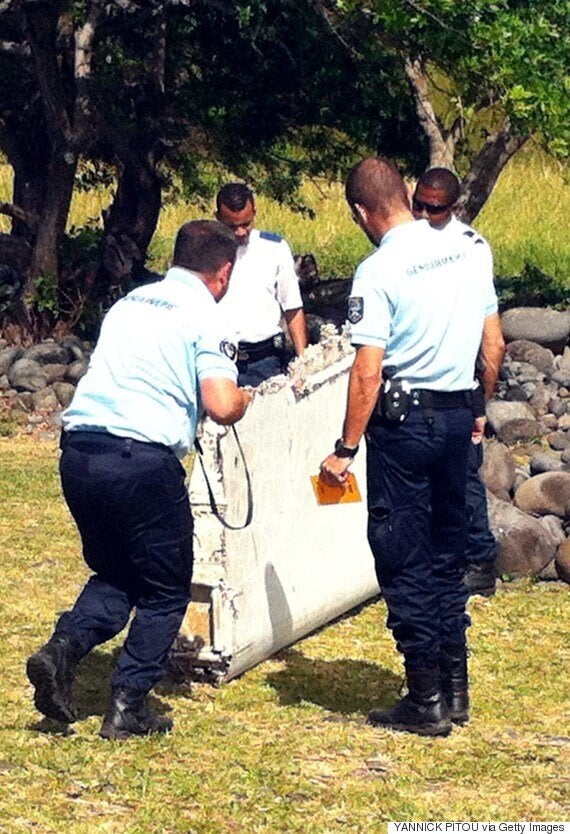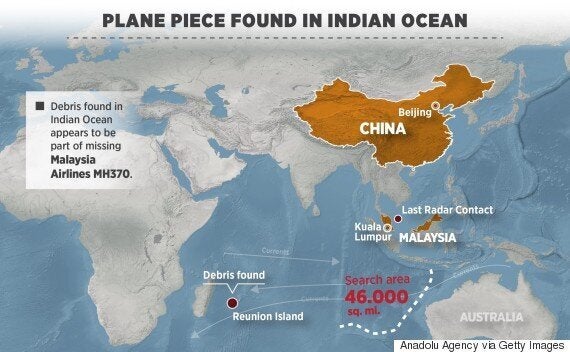Experts in France are due to begin examining part of an aircraft wing which washed up on the shore of Reunion Island last week.
The tests on the flaperon, from a Boeing 777, will help determine if it belongs to the missing Malaysia Airlines flight MH370.
The part was shipped to a laboratory in Toulouse which specialises in analysing aviation debris on Saturday.

Officials carry the flaperon which washed up on Reunion Island last week
Beijing-bound MH370 disappeared from radar with all 239 souls on board on 8 March last year, an hour into its departure from Kuala Lumpur.
Authorities believe the plane most likely crashed offshore from Australia in the east Indian Ocean. Oceanographers say it's feasible the wing fragment floated thousands of kilometers in a counterclockwise direction across the ocean before washing ashore.
SEE ALSO:
Malaysian authorities said this week they'll seek help from territories near Reunion Island to search for more debris.
John Page, an aircraft design expert at the University of New South Wales in Australia, said the discovery of the fragment last week on Reunion Island leads him to conclude the missing Boeing 777 is likely to have broken up when it hit the water nearly 17 months ago.
He said that while the main body of the plane is likely to have sunk, he thinks other small, lightweight parts attached to the wings and tail may have floated free and could still be afloat - pieces like the flaps, elevators, ailerons and rudders.

The debris washed up on the shore of Reunion Island, which is off the coast of Madagascar
"I'm certain other bits floated," he said. "But whether they've washed up anywhere is another question. The chances of hitting an island are pretty low."
He said there's plenty of trash in the ocean, and even if somebody sailing past spotted something in the water, he or she may have no clue it was from the plane.
Page said the heaviest parts of the plane, like the engines, would sink immediately, while other parts might get spread out by the currents before sinking, forming a triangular-shaped debris field on the ocean floor.
He said flight-control surfaces on the wings and tail would be most likely to break off and float because they are essentially carbon-fiber skins filled with air, making them strong but lightweight. They're also designed to be waterproof, so moisture doesn't enter them and freeze during flight.
"What makes aircraft work are their light structures," he said.
Depending on how the aircraft broke up, Page said, it's possible other pieces could float. Those could include plastic and fiberglass trim, door panels, even personal belongings or luggage. He said it was unlikely any human remains would have survived very long.
Mark Tuttle, a professor in mechanical engineering at the University of Washington, said in an email that all structural materials used in transport aircraft are heavy enough they will sink in saltwater. He said the only time they will float, as he suspects is the case with the flaperon, is when a design feature like air trapped inside causes them to remain buoyant.
Geoff Dell, an air safety investigation expert and associate professor at Australia's Central Queensland University, said he, too, would expect the parts most likely to break free and float would be the flight-control surfaces. Many are attached to the plane only with hinges.
He said the amount of floating debris would be determined by the way the plane hit the water, which remains unknown.
He said if it hit in an uncontrolled manner and at a high speed, the plane would likely break up more, allowing more debris to float. A more controlled landing, on the other hand, could result in more of the plane remaining intact and sinking, he said.
Dell said some parts of the plane that might initially float, such as a seat that broke free from the fuselage, could become degraded and saturated over time and eventually sink.
Michael Smart, a professor of aerospace engineering at the University of Queensland, said there was some reason for hope in the search.
"If one piece turns up, perhaps there's a likelihood that others will as well," he said. "It's strange to think you'd find one part that floated and nothing else."
